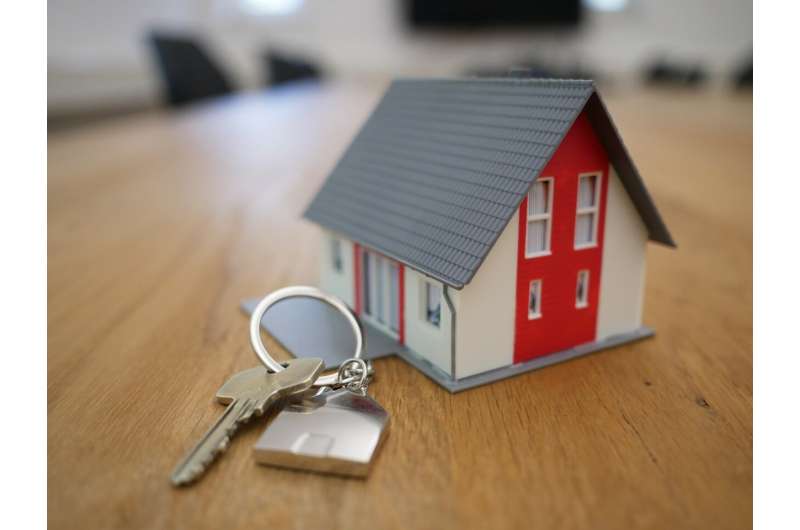This article has been reviewed according to Science X's editorial process and policies. Editors have highlighted the following attributes while ensuring the content's credibility:
fact-checked
trusted source
written by researcher(s)
proofread
Four environmental red flags to watch out for when buying your new home

Have you ever contemplated purchasing an environmentally friendly home but found yourself unsure of where to begin? I can relate if so, as I was in your shoes about a year ago when I set out to purchase my first home.
Amid the escalating climate crisis, there has been a noticeable shift towards the construction of energy-efficient homes. The UK government aims to make all new homes highly energy efficient with low-carbon heating from 2035.
However, for those of us who prefer to live in or near to a city center, the choices for new housing are quite limited. The alternatives are existing homes and apartments, many of which were built many decades ago without much consideration for energy efficiency.
As a leading expert in net zero, I thought I had all the necessary knowledge to make the right choices. But, swayed by my emotions, intuition, the location and stunning views, I made some costly mistakes. These included choosing a listed house with no insulation, single-glazed windows, and a heating system in dire need of an upgrade.
Nevertheless, these missteps have provided me with invaluable lessons that can be of benefit to you, if you're in the market for a new home. Here are four telltale signs that suggest a property isn't as eco-friendly as it could be.
1. Single-pane windows
According to a 2011 study carried out by the Chartered Institute of Building, a global construction management and leadership organization, a typical house in the UK loses 10% of its heat through its windows and 15% through external doors. That's a lot of heat.
So, it's crucial to pay attention to the windows of your prospective home. Look out for single-pane windows and any gaps between the frames that could lead to drafts.
The good news is that you can improve thermal comfort and reduce energy costs by selecting the right windows and frames. Installing A-rated double glazing to windows in a single-glazed, semi-detached property in the UK could save you £155 a year in energy costs and 375kg of carbon dioxide emissions.
2. Cold walls
A poorly insulated home can result in unnecessary energy consumption too. In fact, a standard UK home loses approximately 35% of its heat through the walls and 15% through the roof.
It is difficult to see insulation, but you can check by feeling the walls. If you detect cold spots, especially during the winter, it might be indicative of poor insulation.
When in doubt, consulting the energy performance certificate of the house you're considering purchasing is a wise step. This should tell you if there is insulation, what type of insulation it is (insulation made from natural materials like wood fiber or sheep's wool is the best eco option), and how suitable it is for your location.
My own research suggests that Scottish homes with proper insulation are 24% more likely to maintain an indoor temperature between 20°C and 25°C, and experience a 67% lower likelihood of overheating (where the indoor temperature exceeds 25°C). But despite this fact, little more than half (52%) of UK dwellings had cavity or solid wall insulation in 2021.
3. Old boilers
When you're looking at a property, one of the first things to ask should be whether you can test the boiler or heating system. If the radiators fail to heat up, you encounter rattling or banging noises, or detect unpleasant smells from the boiler, then it probably needs replacing.
On average, heating and hot water accounts for over half of what you spend in a year on energy bills, so having a good boiler is important. Modern boilers are more efficient than older ones, in part because they are "condensing." This means they recover heat from the exhaust gas and use it to heat the central heating water.
Make sure you thoroughly examine the property's thermostat and boiler features. Certain boilers are OpenTherm compatible, meaning they can communicate with a smart thermostat, thereby enhancing a home's temperature regulation.
Another heating system you may want to look for are heat pumps. These are far more efficient than conventional heating technologies and ideally suited for well-insulated homes. But, as with electric boilers, the carbon savings associated with heat pumps will depend on how green the electricity is that powers them.
4. Leaky radiators
Radiators are the typical way we distribute heat around our homes. However, older radiators may contain blockages that result in uneven temperature distribution and, in some instances, no heat at all.
Inspect the radiators closely. Search for any signs of water leakage around the radiators and listen for unusual noises while the heating system is running. If they look to be a decade old or more, they might need to be replaced.
Underfloor heating distributes heat more evenly throughout a house than traditional radiators, all while operating at a lower temperature. Another potentially more environmentally friendly alternative is electric heating—but again, its sustainability ultimately depends on whether your energy provider uses renewable energy sources.
It is important to note that finding a property with all the desired eco-friendly features may present a challenge. However, some of these features, particularly double-glazed windows, are fairly straightforward to install in most homes and will yield substantial benefits in the future.
This article is republished from The Conversation under a Creative Commons license. Read the original article.![]()















